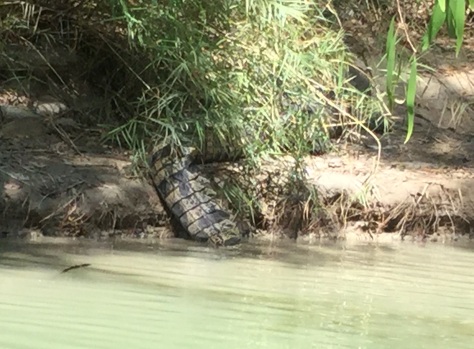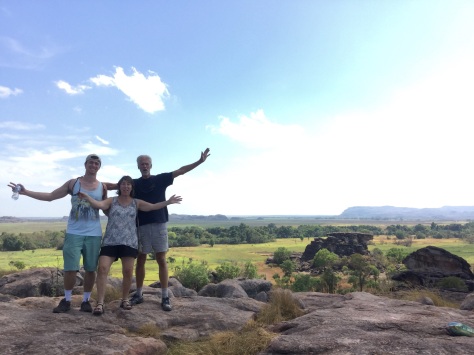Australia is big. And varied. We had a week to spare to explore it… So the strategy was to choose just one area, and we chose the Northern Territory. Hallie, Jesse and I flew to Darwin and did four days of tours in Kakadu National Park. This area has spectacular scenery plus it is the home of many of the aboriginal people who lived here for 50,000 years +/- before Europeans showed up with metal and guns and greed and diseases.
Of course the arrival of the Europeans did not go well for the people whose home this was. In many ways what happened is similar to what happened in North America when the Europeans arrived. One difference is that this area is remote, harsh, tropical — not a place that was readily overrun with immigrants. So there are still large areas that are nearly “wild,” and still the homeland of the people who are now called the “traditional owners” of the land. In fact, in Arnhem Land whites cannot enter without a permit.
The aboriginal culture is complex, and I understand little of it. The creation myths are referred to (by English translators/interpreters) as Dreamtime. But Dreamtime is not exactly a “time” — it is not just a distant past, it is another dimension of experience that can be accessed today. There is no written language. There are Stories. And there are paintings on the rock that relate to the Stories.
Each child born falls into a classification system that determines who s/he can marry. It also determines which Stories are his/hers. All children learn Stories for a level of general knowledge, but the “graduate level” gets more specialized. You must learn the particular Stories for your group, and tell them and pass them on.
All the indigenous animals have creation Stories. For example, the long neck turtle and the echidna (similar to a hedgehog) were friends that did everything together. The echidna had a baby. One day the echidna wanted to go far in search of food, and she asked the turtle to watch her baby. A long time went by, and the echidna didn’t return. The turtle got very hungry. Still the echidna didn’t return, and the hungry turtle ate the baby echidna. And then the mother returned, with plenty of food. “Where is my baby?” she asks. “I was very hungry, and I ate the little one,” the turtle replies. The echidna says, “You are not my friend.” And the two of them fight. The echidna throws stones at the turtle. The turtle takes handfuls of sharp cane grass, and beats the echidna with them. And that is why the turtle has a stone-like shell, and the echidna has sharp spines.
One of our guides explained that you must learn to “feel” with more than the five western senses. He had our group walk over an area where he said we might be able to sense something unusual. Nobody noticed. He turned to Hallie, and said, “Didn’t you feel that?” Hallie apparently has an aura that told him she would be more attuned to the vibrations. The source of the vibration in this case was underground water. He then had Hallie stand in a particular spot, where her body felt an internal heat. This, he said, was a stagnant underground pool. Not a good place to make your camp. Westerners make the mistake all the time of buying or building a house where the energy is bad. Such a simple mistake to avoid if you are tuned in. The aboriginal children grow up tuning in. All children sense these energies, he tells us, but in the West we teach children that these sensations are not real, while here the children are encouraged to develop the ability.
Our guides were fabulous — gentle, caring people willing to share a wealth of information. We could only absorb a tiny amount. But Jesse got recommendations for two books, so we can learn more.
Although the locals divide the year into six seasons, the big distinction is wet versus dry. We are at the end of the dry season. This means that most areas are accessible by 4WD, but the waterfalls have no falling water. In the wet season many of the areas we visited are under 3 or 4 metres of water! Because it is dry season, the crocodiles are in the remaining water, in the billabongs. In wet season they spread out over the flooded countryside. So…we saw LOTS of crocs!




The photos above are just from Day 1… Brace yourself for three more days!










End of Day 2 of our four days in Kakadu. Next we head for Jim Jim Falls and Twin Falls. The falls are from an escarpment 500 kilometers long, down to the flat floodplain below. The river gorge is not the result of water erosion, but of the shifting plates of the earth’s surface ripping open this long rift.







Back to our comfy hotel (built in the shape of a crocodile), exhausted. But we still have another day in Kakadu, starting with Ubirr Rock…












A few more images courtesy of Indu…
































Amazing! So happy to see you reunited with your family! xox
Cindy Fatsis Sent from my iPhone
>
LikeLike
Wow! amazing pictures! Arnhem reminds me of the Canyon de Chelly in AZ where you are only allowed onto the floor of the canyon with a Navajo guide.
LikeLike
Wonderful photos, fascinating paintings, I’d love to see them. Ever see a croc after/catch anything?
LikeLike
Nope — barely saw crocs even move, except for a very slow swim.
LikeLike
Have you tried getting a closer look?
LikeLike
Wow! Very interesting rock formations. Love the rock art!. I love that the aboriginal people are referred to as the “traditional owners of the land”. Maybe we should adopt that terminology here in the states. So glad you guys are having fun. Can’t wait to hear all about the trip, the rock art, animals, the people, etc. Hugs to all. Kathy
LikeLike
So many experiences in such a short time! So much to think about. Love to all, Bill
LikeLike
Those were some amazing days with some very special people.
Thank you Holland family for being part of my journey 🙂
‘Even more important than the glass half full is the fact that it is a beautiful glass’
May the adventures continue.
LikeLike
The Aboriginal people have one of the most complex kinship system of anywhere in the world! I travelled a bit farther south than where you were – to Alice and Ayers Rock – loved the vast openness.
Great photos and you all are clearly having a grand adventure! Best, Dee
LikeLike